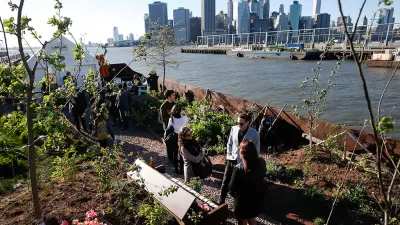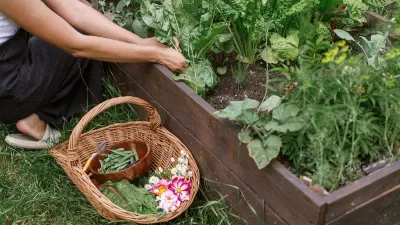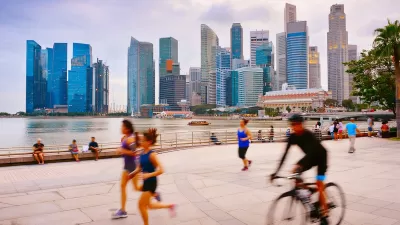Be a better person; be a better planner. Musings from a planner who wants to improve our profession for 2011. Here’s how:
Be a better person; be a better planner. Musings from a planner who wants to improve our profession for 2011. Here's how:
1. Live up to the intrigue of the profession. Yes,when I tell people I'm a City Planner I can see a hint of envy in their expression. City planner has an immediate coolness factor. It oozes power and mystery. And I have to imagine that most planners felt this way about the profession when they first started their careers. How extraordinary to shape cities and make them better places to live. To improve people's lives with small changes and big ones too. Like the hand of God playing with tiny model buildings, moving mountains, streams, and trees. If we're lucky we'll all have a chance to work on one phenomenal project- a Millenium Park, a Portland Streetcar, a Manhattan High Line Park, a South Beach renaissance. But in the meantime, why not ramp up our planning work, revive that cool persona and be a better planner?
2. Eat less. Exercise more. No you're not fat, but our cities are. Let's do a better job planning for parks, jogging paths, walking paths, and walkable blocks. Mandate streets which are interesting to walk down. Plant more trees, require storefronts which are scaled to people and connect places with more attractive routes to make longer distances seem shorter. Give people a reason to walk. Work with all the departments in your city to do this. Planners are interdisciplinary by education. Use this skill to design our cities for recreation and activity.
3. Promote urban farming. Do you know where the lettuce from salad was grown or where that chicken you're about to eat was raised? Why should you care? Massive commercialization of farms and meats has created an extremely convenient and reliable food supply which is efficiently distributed to the nation and the world, but the model is inherently fragile and raises questions about long term sustainability and self sufficiency. Food sources are not clearly labeled and it is difficult to measure the social and environmental impact of transporting that unripe avocado from a nameless California City to my local grocery store in Miami not to mention the low-income neighborhoods which don't even have a decent place to buy avocados. Locally grown and raised food circumvents this system and offers high quality alternatives for a community. As planners we can make it easier for small local and urban farmers to plant, grow, and sell produce within the community by developing policies and regulations which not only permit these uses, but encourage them with incentives.
4. Stop letting large-scale developers design our cities. I'm so tired of reading about the next big mixed-use development and communities hedging their bets on a single project. Great cities aren't made by lifestyle retail centers or glorified shopping malls, they are made with incremental investments from many different people. People who are risk takers with a vision. Cultivate these small investors in your community. Make it easier to develop on small lots and remove the financial barriers which discourage the individual entrepreneur from taking that risk toward making their neighborhoods better places to live. Provide good information on the permitting process and develop ways to expedite approvals for small projects. Create redevelopment districts which attract small investors and discourage large scale homogeneous development.
5. Don't underestimate the importance of aesthetics, sense of community, and social offerings for making cities where people want to live long term. In their Soul of the Community study, the James L. Knight Center and Gallup polled 26 cities three times in three years and found that in all 26 cities a place's beauty, it's tolerance for different people and families, and its cultural and recreational amenities connect people most to their cities and keep them there. More important than economics, politics, and education, people want to live in cities that offer a better quality of life. Consider this information when budgeting for the next fiscal year and setting goals for planning in your community. Set higher standards for arts and culture and invest in your parks, museums, and waterfronts. It's what people want and its what they need. www.soulofthecommunity.org/
So at the start of this new year consider how to be a bolder professional, make great cities, and be better planner!

Planetizen Federal Action Tracker
A weekly monitor of how Trump’s orders and actions are impacting planners and planning in America.

Maui's Vacation Rental Debate Turns Ugly
Verbal attacks, misinformation campaigns and fistfights plague a high-stakes debate to convert thousands of vacation rentals into long-term housing.

Restaurant Patios Were a Pandemic Win — Why Were They so Hard to Keep?
Social distancing requirements and changes in travel patterns prompted cities to pilot new uses for street and sidewalk space. Then it got complicated.

In California Battle of Housing vs. Environment, Housing Just Won
A new state law significantly limits the power of CEQA, an environmental review law that served as a powerful tool for blocking new development.

Boulder Eliminates Parking Minimums Citywide
Officials estimate the cost of building a single underground parking space at up to $100,000.

Orange County, Florida Adopts Largest US “Sprawl Repair” Code
The ‘Orange Code’ seeks to rectify decades of sprawl-inducing, car-oriented development.
Urban Design for Planners 1: Software Tools
This six-course series explores essential urban design concepts using open source software and equips planners with the tools they need to participate fully in the urban design process.
Planning for Universal Design
Learn the tools for implementing Universal Design in planning regulations.
Heyer Gruel & Associates PA
JM Goldson LLC
Custer County Colorado
City of Camden Redevelopment Agency
City of Astoria
Transportation Research & Education Center (TREC) at Portland State University
Jefferson Parish Government
Camden Redevelopment Agency
City of Claremont






























